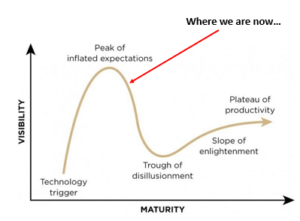Wretched indeed is the plight of the urban mobility planner. On the one hand, the advent of automated vehicles (AV) promises to relieve the cost, perils, and tedium of urban travel. But on the other hand, anticipating the policy actions and infrastructure investments needed to accommodate the new technologies remains extraordinarily difficult.
Most fundamentally, the pace and direction of the underlying technology defies prediction. And so, any investment in road infrastructures, typically lasting from 30 years to forever, must be flexible enough to provide for the current human-piloted traffic as well as the new robotic vehicles during the transition. Throughout this lengthy transition, wise and flexible policies will be needed to ensure public acceptance of the new technology. These challenges reinforce one another.
As a result, the exuberant forecasts of the past few years now appear increasingly irrational. The hype-cycle has crested, and so we begin the slide into the trough of disillusionment, the ideal place from which to plan the AVs’ recovery.

Subsequent essays will propose ways to reverse this incipient plunge, but first we must understand the real-world nature of the challenges.
The Technology Challenge
Deep learning algorithms (DL) set the pace for advances because they learn from experience and thereby adapt to road, traffic, and weather conditions. Supporting the DL are: advanced sensors; light-weight, low-power computing; and cost declines in electric power trains. DL performance in combination with the supporting technologies has advanced powerfully in recent years, fueling the rising expectations of the early hype cycle.
But even as automated vehicles learn to navigate the road and traffic control infrastructures, they increasingly face another kind of challenge: the interface with humans whose actions they can neither anticipate nor control. How should an automated system (always rational, attentive, and unemotional) interact with the “human system” (capable of good judgment, but sometimes irrational, distracted, aggressive, or even drunk)? The rules of encounter are not obvious.
Sharing the Road
Consider a typical urban traffic situation: a downtown intersection during peak hours. Pedestrians and human driven vehicles compete for the scarce times during which passage may be gained.
The black car at the top of the page is attempting to make a turn through a flow of pedestrian traffic, which appears to be opening for the vehicle. In effect, a social transaction is being made between those on foot and those in the car. The humans on both sides negotiate their passage by signaling intent—through eye contact, body language, gestures (perhaps impolite), and occasionally the horn. Normal humans are skilled at understanding these signals. It remains unclear how deep learning algorithms can learn the needed skills…or once learned, whether the laws would allow them to be employed at all.
The difficulty arises from extracting meaning and intent from a social situation. Consider the image below [1]. The picture is a bit fuzzy, but most humans would identify Barak Obama as the central figure. The mirrors with their images of the action would complicate DL interpretation.
Most humans could readily understand the transaction and the intent of the actors, often giving a humorous interpretation. The current deep learning algorithms would be flummoxed.

Synthetic Judgment and the Human Interaction
Difficulties notwithstanding, recent developments offer promising solutions. In 2017 a DL-enhanced program from DeepMind [https://deepmind.com/] defeated skilled human players in a game of poker…a game of deception and imperfect information. The algorithm grew to recognize a bluff and even apply it in suitable situations. It is now being employed in defense simulation, and might be adapted to traffic situations, perhaps an apt analogue [2]. And in late January of this year, DeepMind announced a new DL breakthrough in which its AlphaStar system defeated highly skilled human players in the most challenging of real-time strategy games, StarCraft [3].
Probabilistic DL strategies supplement the DL algorithms by continuously evaluating the likelihood of safety-related actions by other vehicles and reconsidering decisions made an instant ago. This elicits new information in real time and hence arrives at better decisions. Such capabilities could lead to a fundamental, general form of artificial intelligence and eliminate the need for any accommodation whatsoever by the road infrastructure.
Thus the chief uncertainty, synthetic judgment for the human interaction, appears resolvable, but the timing of this resolution remains opaque.
The Troubles of the Day are Sufficient
The commercial self-driving cars now on the road have no interpretive capabilities. Instead, they substitute strict adherence to the traffic rules for situational judgment. In contrast, human-driven cars are all about situational judgment. They move a bit over the speed limit (sometimes a lot over), and they often interpret a stop sign as a suggestion to pause. The robots have none of these bad habits, and so are seen by humans as obstacles to the flow of traffic.
This is generating much public animosity. In Arizona, for example, the Waymo AVs provoke violent protests from some drivers they encounter on the streets [4]. And at the same time (rather ironically), public opinion surveys show decreasing confidence in the safety of the self-driving cars [5].
Thus the planners’ dilemma: when might self-driving cars gain a capability for synthetic judgment sufficient to mesh with humans? And while the technology advances, should investments in infrastructure or traffic policies be employed to offset the robotic disadvantage and allow for a smoother transition? How does the planner play the game of real life? More on this in subsequent essays.
References
[1] Fridman, Lex. Deep Learning Basics Public lecture presented at MIT on 11 January, 2019 and available at: https://www.youtube.com/watch?v=O5xeyoRL95U
Further MIT courses available at: https://deeplearning.mit.edu/
[2] Simonite, T. “A Poker-Playing Robot Goes to Work for the Pentagon” Wired, 16 January, 2019. Available here
[3] Described fully at: https://deepmind.com/blog/alphastar-mastering-real-time-strategy-game-starcraft-ii/
[4] Romero, S. “Wielding Rocks and Knives, Arizonans Attack Self-Driving Cars” New York Times, 31 December, 2018. Available at: https://www.nytimes.com/2018/12/31/us/waymo-self-driving-cars-arizona-attacks.html
[5] Rapier, G. “As more self-driving technology launches, people are growing more anxious about the supposed benefits” BusinessInsider, 12 January, 2019. Available at: https://www.businessinsider.com/self-driving-car-worries-grow-despite-new-products-2019-1



Leave a Reply